Figures & data
Figure 1. Circular RNA circZNF609 (circZNF609) was higher expressed in prostatic cancer (PC) tissues. (NT: non tumour, T: tumour). The level of circZNF609 was conspicuously higher expressed in PC tissues. (***p < .001).
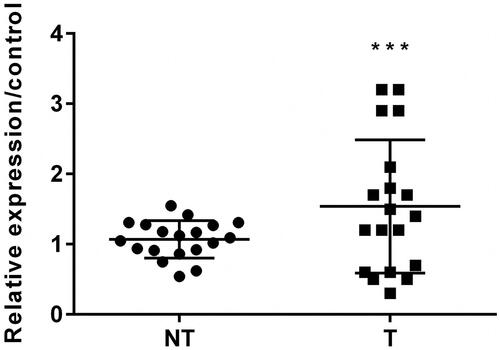
Figure 2. Circular RNA circZNF609 (circZNF609) was silenced in PC3 and LNCaP cells. The level of circZNF609 was declined in PC3 and LNCaP cells while circZNF609 was silenced. (***p < .001).
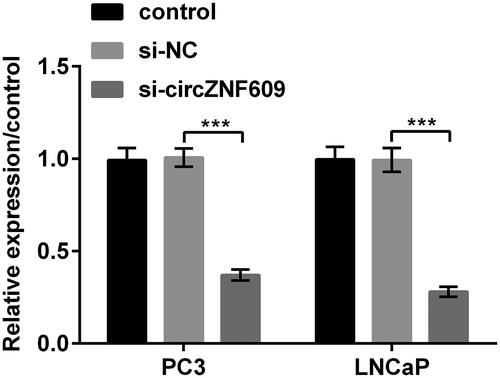
Figure 3. Silencing circular RNA circZNF609 (circZNF609) restrained cell viability and colony formation and caused apoptosis. (A) Silencing circZNF609 meaningfully restrained PC3 and LNCaPcell colony ability. (B) Silencing circZNF609 meaningfully restrained PC3 and LNCaPcell viability. (C) Silencing circZNF609 meaningfully enhanced PC3 and LNCaPcell apoptosis. (D–F) Silencing circZNF609 meaningfully heightened the expressions of Cleaved-Caspase-3 and Cleaved-Caspase-9. (***p < .001).
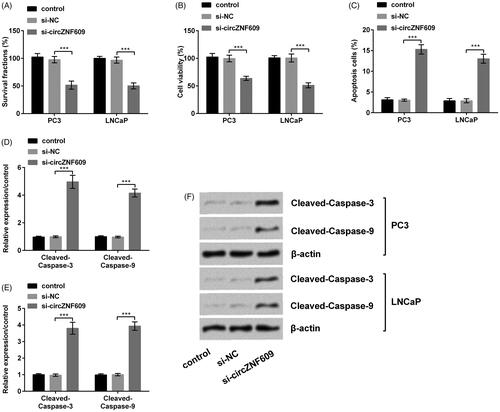
Figure 4. Silencing circular RNA circZNF609 (circZNF609) restrained cell migration and invasion. (A) Silencing circZNF609 restrained cell migration in PC3 and LNCaP cells. (B) Silencing circZNF609 restrained cell invasion in PC3 and LNCaP cells. (C–E) Silencing circZNF609 restrained the levels of matrix metalloproteinase-9 (MMP-9) and Vimentin in PC3 and LNCaP cells. (**p < .01; ***p < .001).
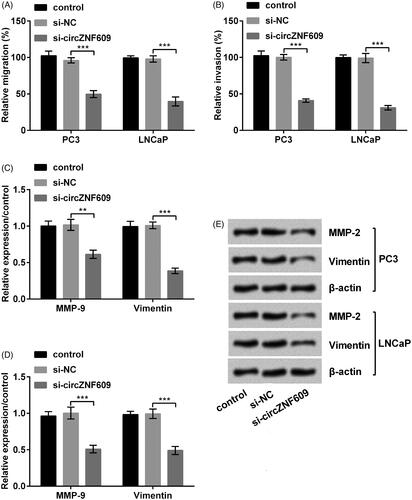
Figure 5. Silencing circular RNA circZNF609 (circZNF609) up-regulated microRNA (miR)-186-5p. When circZNF609 was silenced in PC3 and LNCaP cells, the level of miR-186-5p was meaningfully enhanced. (***p < .001).
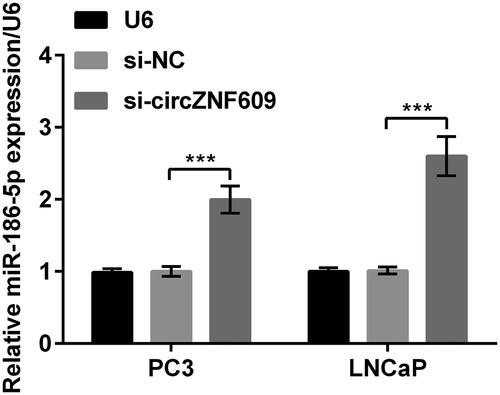
Figure 6. Silencing circular RNA circZNF609 (circZNF609) restrained cell viability by up-regulating microRNA (miR)-186-5p. (A) miR-186-5p inhibitor conspicuously declined the level of miR-186-5p. (B) miR-186-5p inhibitor conspicuously enhanced the circZNF609-induced decline in PC3 and LNCaP cell colony. (C) miR-186-5p inhibitor conspicuously enhanced the circZNF609-induced decline in PC3 and LNCaP cell viability. (D) miR-186-5p inhibitor conspicuously declined the circZNF609-induced rise in PC3 and LNCaP cell apoptosis. (E–G) Silencing circZNF609 meaningfully declined expressions of Cleaved-Caspase-3 and Cleaved-Caspase-9, miR-186-5p inhibitor conspicuously reversed this expression. (*p < .05; **p < .01; ***p < .001).

Figure 7. Silencing circular RNA circZNF609 (circZNF609) restrained cell migration and invasion through up-regulating microRNA (miR)-186-5p. (A) miR-186-5p inhibitor conspicuously enhanced circZNF609-induced decline in PC3 and LNCaP cell migration. (B) miR-186-5p inhibitor conspicuously enhanced the circZNF609-induced decline in PC3 and LNCaP invasion. (C–E) Silencing circZNF609 meaningfully declined levels of matrix metalloproteinase-9 (MMP-9) and Vimentin, and miR-186-5p inhibitor conspicuously reversed this expression. (*p < .05; **p < .01; ***p < .001).

Figure 8. Silencing circular RNA circZNF609 (circZNF609) restrained YAP1 and AMPK signaling pathways through up-regulating miR-186-5p. (A) Silencing circZNF609 restrained YAP1 pathway through up-regulating miR-186-5p in PC3 cells. (B) Silencing circZNF609 restrained YAP1 pathway through up-regulating miR-186-5p in LNCaP cells. (C) Silencing circZNF609 restrained AMPK pathway through up-regulating miR-186-5p in PC3 cells. (D) Silencing circZNF609 restrained AMPK pathway through up-regulating miR-186-5p in LNCaP cells. (**p < .01; ***p < .001).
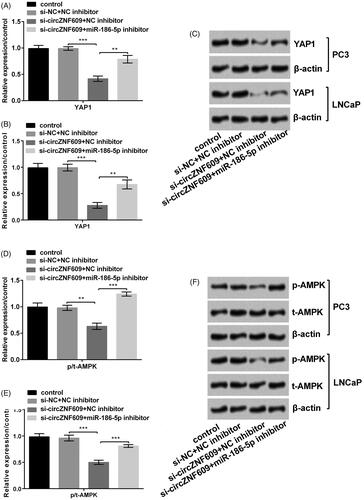
Data availability
The datasets used and/or analyzed during the current study are available from the corresponding author on reasonable request.
